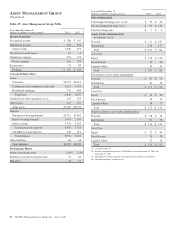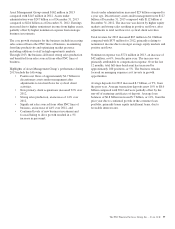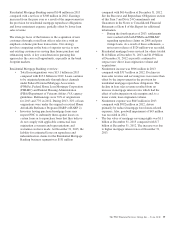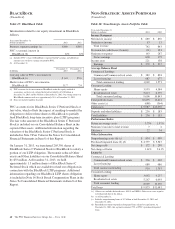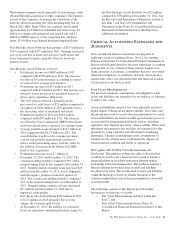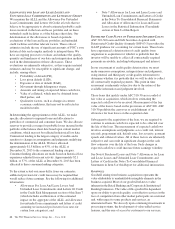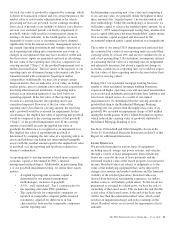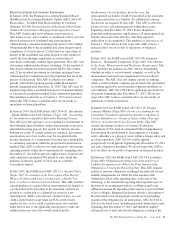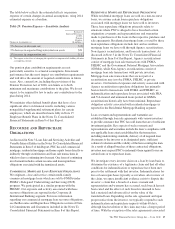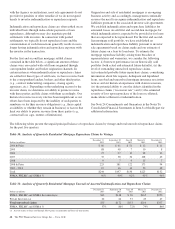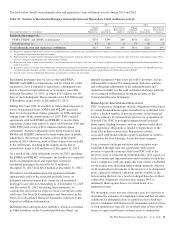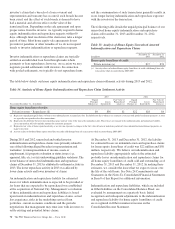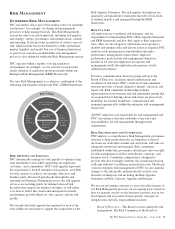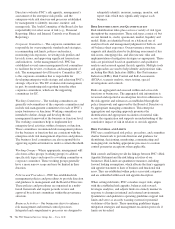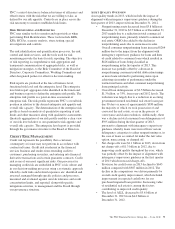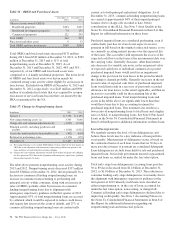PNC Bank 2013 Annual Report Download - page 84
Download and view the complete annual report
Please find page 84 of the 2013 PNC Bank annual report below. You can navigate through the pages in the report by either clicking on the pages listed below, or by using the keyword search tool below to find specific information within the annual report.beginning of 2014. We do not expect this ASU to have a
material effect on our results of operations or financial position.
R
ECENT
A
CCOUNTING
P
RONOUNCEMENTS
See Note 1 Accounting Policies in the Notes To the
Consolidated Financial Statements in Item 8 of this Report
regarding the impact of new accounting pronouncements
which we have adopted.
S
TATUS OF
Q
UALIFIED
D
EFINED
B
ENEFIT
P
ENSION
P
LAN
We have a noncontributory, qualified defined benefit pension
plan (plan or pension plan) covering eligible employees.
Benefits are determined using a cash balance formula where
earnings credits are applied as a percentage of eligible
compensation. Pension contributions are based on an actuarially
determined amount necessary to fund total benefits payable to
plan participants. Consistent with our investment strategy, plan
assets are primarily invested in equity investments and fixed
income instruments. Plan fiduciaries determine and review the
plan’s investment policy, which is described more fully in Note
15 Employee Benefit Plans in the Notes To Consolidated
Financial Statements in Item 8 of this Report.
We calculate the expense associated with the pension plan and
the assumptions and methods that we use include a policy of
reflecting trust assets at their fair market value. On an annual
basis, we review the actuarial assumptions related to the
pension plan. The primary assumptions used to measure
pension obligations and costs are the discount rate,
compensation increase and expected long-term return on
assets. Among these, the compensation increase assumption
does not significantly affect pension expense.
The discount rate used to measure pension obligations is
determined by comparing the expected future benefits that will
be paid under the plan with yields available on high quality
corporate bonds of similar duration. The impact on pension
expense of a .5% decrease in discount rate in the current
environment is a decrease of $2 million per year. This
sensitivity depends on the economic environment and amount
of unrecognized actuarial gains or losses on the measurement
date. This amount is significantly lower than in recent years
since amortization of prior year net actuarial losses will not be
required in 2014.
The expected long-term return on assets assumption also has a
significant effect on pension expense. The expected return on
plan assets is a long-term assumption established by
considering historical and anticipated returns of the asset
classes invested in by the pension plan and the asset allocation
policy currently in place. For purposes of setting and
reviewing this assumption, “long term” refers to the period
over which the plan’s projected benefit obligations will be
disbursed. We review this assumption at each measurement
date and adjust it if warranted. Our selection process
references certain historical data and the current environment,
but primarily utilizes qualitative judgment regarding future
return expectations.
To evaluate the continued reasonableness of our assumption,
we examine a variety of viewpoints and data. Various studies
have shown that portfolios comprised primarily of U.S. equity
securities have historically returned approximately 10%
annually over long periods of time, while U.S. debt securities
have returned approximately 6% annually over long periods.
Application of these historical returns to the plan’s allocation
ranges for equities and bonds produces a result between 7.00%
and 7.75% and is one point of reference, among many other
factors, that is taken into consideration. We also examine the
plan’s actual historical returns over various periods and
consider the current economic environment. Recent
experience is considered in our evaluation with appropriate
consideration that, especially for short time periods, recent
returns are not reliable indicators of future returns. While
annual returns can vary significantly (actual returns for 2013,
2012 and 2011 were +15.48%, +15.29%, and +.11%,
respectively), the selected assumption represents our estimated
long-term average prospective returns.
Acknowledging the potentially wide range for this
assumption, we also annually examine the assumption used by
other companies with similar pension investment strategies, so
that we can ascertain whether our determinations markedly
differ from others. In all cases, however, this data simply
informs our process, which places the greatest emphasis on
our qualitative judgment of future investment returns, given
the conditions existing at each annual measurement date.
Taking into consideration all of these factors, the expected long-
term return on plan assets for determining net periodic pension
cost for 2013 was 7.50%, down from 7.75% for 2012. After
considering the views of both internal and external capital
market advisors, particularly with regard to the effects of the
recent economic environment on long-term prospective fixed
income returns, we are reducing our expected long-term return
on assets to 7.00% for determining pension cost for 2014.
Under current accounting rules, the difference between
expected long-term returns and actual returns is accumulated
and amortized to pension expense over future periods. Each
one percentage point difference in actual return compared
with our expected return causes expense in subsequent years
to increase or decrease by up to $9 million as the impact is
amortized into results of operations.
We currently estimate pretax pension income of $9 million in
2014 compared with pretax expense of $74 million in 2013.
This year-over-year expected decrease reflects the impact of
favorable returns on plan assets experienced in 2013, as well
as the effects of the higher discount rate required to be used in
2014.
66 The PNC Financial Services Group, Inc. – Form 10-K


